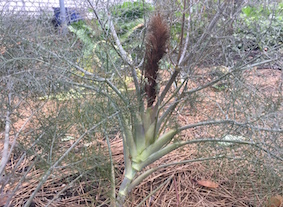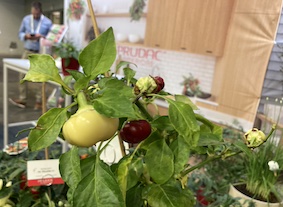Growing and Using Bronze Fennel
Views: 4662

Earlier in the season I mentioned making what is called a “Fridge-Dive Pesto”. Basically, it’s a pesto made from hardy greens and leafy herbs in the garden. I put my own spin on it by using trimmings from herbs and veggies and also the seedlings of dill and bronze fennel that pop up in my garden. Thanks to my community garden neighbor who is growing dill and fennel, I had A LOT of those little guys in my own plot.
Since that pesto-making adventure, I’ve actually left a few bronze fennel seedlings to grow. They are basically free plants, so I wanted to get the most out of them and explore what bronze fennel can do.
What Is Fennel?
First, let me explain fennel a bit. It’s a tender perennial that is hardy to about Zone 6, and is typically grown for its bulb (especially the green form of the plant) but the frilly fronds and tender stems can be used in the kitchen, too. The whole plant—whether it’s the green or bronze-colored form—has a licorice or sweet anise flavor and fragrance, and a little goes a long way in flavoring salad dressings, salads, butters, oils and sugars. You can even sprinkle chopped leaves on main dishes such as fish and beef. I also heard that the fennel seeds work as a breath freshener. I’ll have to give that a try!
Oh, and let me mention—it’s a beautiful plant! Even if you dislike the taste of licorice, you’ll certainly enjoy the texture and movement fennel’s frilly, wind-catching fronds bring to an ornamental garden. Fennel is definitely one of those plants equally at home in the vegetable and flower garden.
How To Grow Fennel
Fennel typically grows to about 3 ft. tall. However, my neighbor’s bronze fennel has got to be nearing 6 ft. if an inch. I think that’s because it’s growing in the ideal conditions for that plant—well-drained, fertile soil with lots of organic matter, full sun (at least six hours each day) and consistently moist soil. I also think it’s so big because she may have been able to overwinter this tender perennial. Meaning, it was already established from last year.
Harvesting Fennel
Harvest leaves anytime during the growing season, keeping in mind to never harvest more than a third of the leaves at one time—it’ll slow the plant’s growth. Fennel also produces beautiful umbel flowers like Queen Anne’s Lace. Pollinators love them. You can choose to leave the flower buds on or pinch them off to allow the fennel to keep growing. Once any plant goes to seed its growth begins to slow down.
If you live in Zones 6 or warmer, you may choose to keep the fennel growing by lightly mulching it for the winter. Or, you could harvest the whole plant when the bulb is about 4 in. wide. The bulb can be used in slaws. My first experience with cooking fennel was lightly coating thin slabs of it with crumbs and pan frying—it was delightful.
Whichever use you decide on—in the veg or flower garden, flavoring oils or roasting—fennel is probably one of the most versatile plants you’ll ever have. And thank your neighbor for the seedlings!
Meet Ellen Wells
When you’re raised on a farm, you can’t help but know a thing or two about gardening. Ellen Wells is our expert on edible gardening.…
Ellen's Recent Posts

Spooky Red Pumpkin Pepper






